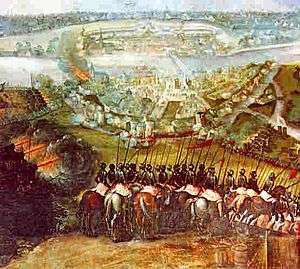Siege of Maastricht (1579)
The Siege of Maastricht was a battle of the Eighty Years' War which lasted from March 12 – July 1, 1579. The Spanish were victorious.
| Siege of Maastricht | |||||||
|---|---|---|---|---|---|---|---|
| Part of the Eighty Years' War | |||||||
 Spanish troops storming the city of Maastricht. | |||||||
| |||||||
| Belligerents | |||||||
|
|
| ||||||
| Commanders and leaders | |||||||
|
Sebastien Tapin† |
| ||||||
| Strength | |||||||
| 1,200–2,000[1][2] | 20,000–34,000[1][2] | ||||||
| Casualties and losses | |||||||
| 900–1000 soldiers, plus 800-4,000 civilians[2] | 4,000[1] | ||||||
Prelude
In 1579 the city of Maastricht was in the hands of the Dutch rebels, who favoured the Protestant Reformation and independence from Spain. Officially, the city was a condominium ruled jointly by the prince-bishop of Liège and the Duke of Brabant. From 1555 the title of Duke of Brabant was held by Philip II, King of Spain and Lord of the Netherlands. On March 12, 1579 the Spanish General Alexander Farnese started to lay siege to the city with his army consisting of 20,000 men. The Dutch garrison consisted of some 1,200 soldiers and some city militia.
Siege
The Spanish commander ordered his troops to sap the walls. The inhabitants of Maastricht too were digging to reach the Spanish tunnels. Deep under ground the fighting continued. Many Spanish soldiers died when mines exploded underground or because of lack of oxygen when the Dutch defenders ignited fires in the tunnels.
Sack
In the night of 29 June, Farnese's troops managed to get into the city while the exhausted defenders were asleep. Since the city had not surrendered after the walls had been breached, 16th-century law of war permitted the victors to loot the conquered city. The Spanish sacked the city for three days during which time many civilians lost their lives. The looting, although greatly exaggerated in later centuries, was particularly violent because Farnese was in bed with fever during the three days of the sack.[2]
Aftermath
Maastricht remained part of the Spanish Netherlands until 1632,[3] when Frederick Henry, Prince of Orange took the city for the Dutch Republic (Capture of Maastricht). Maastricht, which had been an important city in the Netherlands throughout the Middle Ages declined after the mid-16th century but other factors may have contributed to this.[2]
Dutch propaganda prints by Jan Luyken, Romeyn de Hooghe and others, picturing the Spanish atrocities in detail, were produced well into the 17th century. Philip II had a heroic depiction of the Siege of Maastricht painted in the Royal Palace of Aranjuez. The Spanish playwright Lope de Vega wrote the play El asalto de Mastrique, por el príncipe de Parma in 1614. The silver gilded reliquary bust of Saint Servatius in the Treasury of the Basilica of Saint Servatius was a gift from the Duke of Parma to the city of Maastricht after the sack.
References
- David, Saul (2012). The Encyclopedia of War. Dorling Kindersley. ISBN 978-1-4093-8664-3.
- P.J.H. Ubachs & I.M.H. Evers (2005): Historische Encyclopedie Maastricht, page 61. Walburg Pers, Zutphen. ISBN 90-5730-399-X
- In reality, Maastricht was never entirely part of the Spanish Netherlands (or Dutch Republic). From circa 1200 until 1794 it constituted a condominium, the other ruler being the prince-bishop of Liège.
